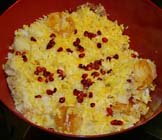Medicinal uses
-
The active components present in saffron have had many therapeutic applications in many traditional medicines for a long time as anti-spasmodic, carminative, and diaphoretic.
-
Research studies have shown that safranal, a volatile oil found in the spice, has antioxidant, cytotoxic effects on cancer cells, anticonvulsant and antidepressant properties.
-
The α-crocin, a carotenoid compound, which gives the spice its characteristic golden-yellow hue, has been found to have antioxidant, antidepressant, and anti-cancer properties. (Medical disclaimer).
Selection and storage
Fresh saffron is available in the specialized spice markets. Try to buy whole dried stigma (pistils) instead of powdered saffron since often it may be adulterated. Choose a well-sealed container from the authentic selling company label displaying the date of the package and expiry.
Fresh spice should feature bright crimson-red color, and when rubbed between fingers, should release a very pleasant aroma and stain golden-yellow. Look for lengthy stamens, each measuring 2 to 4 cm in length. Avoid inferior quality products featuring gray color streaks or light spots on the stigma. This spice has a unique, pungent bitter-honey taste with a pleasant aroma.
Store inside a closed box and keep it in a cool dark place (preferably inside the refrigerator) away from the light since light rays oxidize the pigments in saffron and offset its flavor.
Culinary uses
 |
| Saffron rice seasoned with barberry seeds. |
Just a pinch of fresh saffron is enough to enhance the flavor and color of the entire recipe.
There are several methods to use it in the kitchen. the whole stigma can be added directly to the preparations, or often, the threads are ground to paste using traditional mortar and pestle and added to the recipes. In the third method, a pinch of saffron is added to a cup of hot water, steep; add this water to the ingredients.
Here are some serving tips:
-
Saffron is employed as a flavoring base and coloring base in both food and drinks in the Mediterranean, and Asian cuisines.
-
Popularly known as “Kesar” in the Indian subcontinent, it has been in use in the preparation of rice-pilaf, rice-pudding, “halwa” and other sweet dishes in many Indian, Pakistani, and Central Asian countries. It is also used as a color and flavoring base in the preparation of kulfi, ice creams, cakes, and drinks.
Safety profile
High doses of saffron can act as a uterine stimulant and in severe cases can cause miscarriage. Therefore, pregnant women may be advised to avoid this spice in their diet.
(Medical Disclaimer: The information and reference guides on this website are intended
solely for the general information of the reader. It is not to be used to diagnose health problems or for treatment purposes. It is not a substitute for medical care provided by a licensed and qualified health professional. Please consult your health care provider for any advice on medications.)
≺≺ Back to Spices from Saffron. Visit here for an impressive list of healthy spices with complete illustrations of their nutrition facts and health benefits.
≺≺ Back to Home page.
Further reading:
-
Stanford School of Medicine Cancer information Page- Nutrition to Reduce Cancer Risk.

